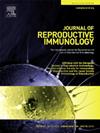Mechanism of FBXW7 mRNA degradation mediated by circSMAD2 through METTL3-METTL14 m6A axis affects proliferation and invasion of endometrial stromal cells
IF 2.9
3区 医学
Q3 IMMUNOLOGY
引用次数: 0
Abstract
This study investigates the role of circSMAD2 in ectopic endometrium of endometriosis (EMS) patients, focusing on its upregulation of FBXW7 m6A level by mediating the formation of the METTL3/METTL14 complex. Ectopic endometria from EMS patients and healthy individuals were compared for the expression levels of FBXW7 and YTHDF2, as well as total m6A levels. Results showed elevated FBXW7 and reduced YTHDF2 expressions in EMS ectopic endometria, along with decreased m6A levels. YTHDF2 was found to bind to FBXW7 mRNA, leading to its degradation and suppression of FBXW7 expression. CircSMAD2 interacted with METTL3/METTL14 complex in human endometrial stromal cells, increasing FBXW7 m6A level without affecting complex expression levels. Overexpression of YTHDF2 or circSMAD2 inhibited cell proliferation, migration, and invasion, effects partly reversed by FBXW7 overexpression. Reduced circSMAD2 expression in EMS resulted in decreased METTL3/METTL14 complex formation and FBXW7 m6A levels, while decreased YTHDF2 expression in EMS led to higher FBXW7 expression, promoting cell proliferation and invasion. This study sheds light on the regulatory mechanism of circSMAD2 in EMS pathogenesis.
Data Availability
The datasets used or analyzed during the current study are available from the corresponding author on reasonable request.
circSMAD2通过METTL3-METTL14 m6A轴介导FBXW7 mRNA降解影响子宫内膜基质细胞增殖和侵袭的机制
本研究探讨了circSMAD2在子宫内膜异位症(EMS)患者异位子宫内膜中的作用,重点关注其通过介导METTL3/METTL14复合物的形成上调FBXW7 m6A水平。比较EMS患者和健康个体异位子宫内膜中FBXW7和YTHDF2的表达水平以及总m6A水平。结果显示,EMS异位子宫内膜中FBXW7表达升高,YTHDF2表达降低,m6A水平降低。发现YTHDF2与FBXW7 mRNA结合,导致其降解并抑制FBXW7的表达。CircSMAD2与人子宫内膜基质细胞中METTL3/METTL14复合物相互作用,增加FBXW7 m6A水平,但不影响复合物的表达水平。YTHDF2或circSMAD2过表达抑制细胞增殖、迁移和侵袭,FBXW7过表达部分逆转了这种作用。EMS中circSMAD2表达降低导致METTL3/METTL14复合物形成和FBXW7 m6A水平降低,而EMS中YTHDF2表达降低导致FBXW7表达升高,促进细胞增殖和侵袭。本研究揭示了circSMAD2在EMS发病机制中的调控机制。数据可获得性本研究中使用或分析的数据集可按合理要求从通讯作者处获得。
本文章由计算机程序翻译,如有差异,请以英文原文为准。
求助全文
约1分钟内获得全文
求助全文
来源期刊
CiteScore
6.30
自引率
5.90%
发文量
162
审稿时长
10.6 weeks
期刊介绍:
Affiliated with the European Society of Reproductive Immunology and with the International Society for Immunology of Reproduction
The aim of the Journal of Reproductive Immunology is to provide the critical forum for the dissemination of results from high quality research in all aspects of experimental, animal and clinical reproductive immunobiology.
This encompasses normal and pathological processes of:
* Male and Female Reproductive Tracts
* Gametogenesis and Embryogenesis
* Implantation and Placental Development
* Gestation and Parturition
* Mammary Gland and Lactation.

 求助内容:
求助内容: 应助结果提醒方式:
应助结果提醒方式:


